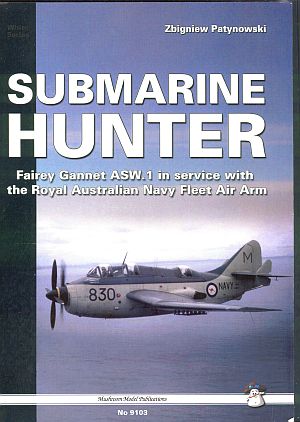- Author
- Book reviewer
- Subjects
- Naval Aviation, Book reviews, Aviation, Naval Technology
- Tags
-
- RAN Ships
- None noted.
- Publication
- December 2008 edition of the Naval Historical Review (all rights reserved)
Submarine Hunter – Fairey Gannet in Service with the RAN Fleet Air Arm.
By Zbigniew (‘Ben’) Patynowski.
Mushroom Model Publications, Redbourn (UK), 2008. 248pp.
Profusely illustrated (b&w and colour)
ISBN: 978-83-89450-57-9.
Reviewed by Ron Robb

This book partially fills a gap in Australian military aircraft history by recording the RAN life of the anti-submarine Fairey ‘Gannet’. This is not the first review of the book as a couple have already been published overseas (as well as locally) no doubt because the publisher is British and has its printing done in Poland. The author, Ben Patynowski, is actually a civilian but has spent several years pulling together a monumental record from a host of Navy people who spent a good deal of their lives flying in and working on this rather unusual aeroplane.
Fairey was a venerable British aircraft manufacturer with a long line of aircraft ranging from plain ugly and of dubious value to outstandingly capable and good looking machines. One writer remarked that the Fairey ‘Barracuda’ was ‘not an easy aircraft to forget’ – especially by the unfortunate aircrew who had to operate it.
On the other hand, the ‘Firefly’ (which preceded the Gannet in RAN service) looked ‘right’ and was an excellent warbird. The Gannet fell somewhere between the two – an ungainly looking machine but fairly effective at its job. This reviewer asked one retired RAN Pilot if he had ever flown one to which he replied ‘Yes, unfortunately, but please don’t let anybody know’. Another retired Navy pilot interviewed in the book referred to the aircraft as ‘an abortion of an aircraft’ that so disenchanted him that he gave up flying.
However, that was not the general recollection of most aircrew; particularly pilots. Indeed, many of them interviewed spoke warmly of an aircraft which, despite its enormous size and ungainly appearance, was light and easy to fly, had excellent forward vision (a big ‘plus’ for carrier borne aircraft), could carry an impressive armament load and, given the technology of the day, was good at its job – hunting submarines.
It had some vices, especially a strange arrangement of power control associated with the undercarriage called ‘the flight fine pitch stop’, which could be deucedly confusing and was responsible for at least one death. The aircraft would occasionally exercise its own mind on arresting when at sea and head for a port sponson, as a couple of photos in the book demonstrate. It had two gas turbine engines powering two propellers which could each be operated independently with its associated engine with the other one shut-down on long patrol as a fuel saving measure (and hence extended patrol time). Mechanically, it had a chequered career with a couple of serious empennage (tail section) problems – which on one occasion caused an awful fatality – main drive gearbox failures and occasionally a spectacular tailpipe night flying fireworks display after start-up as white hot turbine blades were showered rearwards. Ironically, the RAN was just about on top of these problems when the aircraft’s life came to a close prior to being replaced by the American Grumman ‘Tracker’.
The book follows the RAN life of the aircraft from acquisition to demise in a series of sections chronologically. By far the main content is by personal interviews with many officers and sailors, both flyers and maintainers and a few other peripherally associated people for good measure. These reminiscences gradually build up a very good picture of what life around naval aircraft is like, especially at sea on an aircraft carrier. It records every conceivable mood from ghastly tragedy to uproarious humour, ashore and afloat, hard at work and hard at play in Australia and overseas. Many people who operated or worked with the Gannet will find their photo in this book because there is not one page without at least a couple of photos on it. A strong feature of this large book is the huge number of excellent illustrations and it thus makes a good ‘coffee table’ read.
The book has some shortcomings. Most disappointing is that there are few technical details other than in passing conversation in the many interviews and recollections. Other books of this genre (such as the Aerospace Publications series on most other earlier RAN aircraft) give data tables on performance, endurance, engine details, history of all serial numbers, fuselage and engine cutaway sections, and so on. A couple of cockpit layout photos or diagrams would have been enormously helpful in describing the complex starting and in-flight engine shut-down and re-light procedures and in helping to explain the notorious flight-fine-pitch stop terror. The bomb bay view on p.159 is a good example of what can be done in that regard.
Lack of an index is frustrating for researchers and is a common failure in such works. Establishing an index is a tedious job and cannot be done until final print-ready draft, so it is often left out due to shortage of time, but it is an essential primary reference point for future studies and those looking for information on a particular aspect. Such a work thus still remains to be written – which is a pity because most other significant earlier RAN aircraft have now been covered. If space was a problem several of the personal anecdotal items could have been dropped because many people have several entries and some of them are repetitive.
A couple of proof reading errors slipped through – (such as the ‘carnivorous’ bomb bay depicted on p.159, and a couple of pictures whose captions seem to have wandered off somewhere else), but a book of this size and complexity that escapes from the printer with no spelling errors, typos or syntax howlers has yet to be written.




